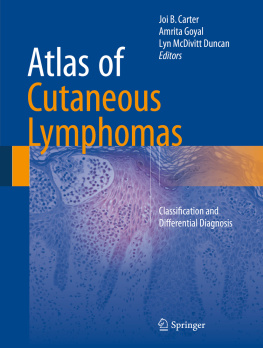Living with Lymphoma
 Living with Lymphoma
Living with Lymphoma
A Patients Guide
2nd Edition
Elizabeth M. Adler, PhD
Foreword by
W. Jeffrey Baker, MD
Introduction by
Michael R. Bishop, MD

Note to the reader. This book is not meant to substitute for medical care of people with lymphoma or other cancers, and treatment should not be based solely on its contents. Instead, treatment must be developed in a dialogue between the individual and his or her physician. This book has been written to help with that dialogue.
Drug dosage. The author and publisher have made reasonable efforts to determine that the selection of drugs discussed in this text conforms to the practices of the general medical community. The medications described do not necessarily have specific approval by the U.S. Food and Drug Administration for use in the diseases for which they are recommended. In view of ongoing research, changes in governmental regulation, and the constant flow of information relating to drug therapy and drug reactions, the reader is urged to check the package insert of each drug for any change in indications and dosage and for warnings and precautions. This is particularly important when the recommended agent is a new and/or infrequently used drug.
2005, 2016 Johns Hopkins University Press
All rights reserved. Published 2016
Printed in the United States of America on acid-free paper
9 8 7 6 5 4 3 2 1
Johns Hopkins University Press
2715 North Charles Street
Baltimore, Maryland 21218-4363
www.press.jhu.edu
Library of Congress Cataloging-in-Publication Data
Adler, Elizabeth M.
Living with lymphoma : a patients guide / Elizabeth M. Adler, PhD ; introduction by Michael R. Bishop, MD ; foreword by W. Jeffrey Baker, MD. Second edition.
pages cm
Includes bibliographical references and index.
ISBN 978-1-4214-1809-4 (hardcover : alk. paper) ISBN 978-1-4214-1810-0 (pbk. : alk. paper) ISBN 978-1-4214-1811-7 (electronic) ISBN 1-4214-1809-6 (hardcover : alk. paper) ISBN 1-4214-1810-X (pbk. : alk. paper) ISBN 1-4214-1811-8 (electronic) 1. LymphomasPopular works. I. Title.
RC280.L9A26 2015
616.99446dc23 2015004319
A catalog record for this book is available from the British Library.
Illustrations by Jacqueline Schaffer
The excerpt from the poem Cancer Garden, on page 133, is from Dream of Order 1997 by Thomas Avena. Published by Mercury House, San Francisco, California, and reprinted by permission.
Special discounts are available for bulk purchases of this book. For more information, please contact Special Sales at 410-516-6936 or .
Johns Hopkins University Press uses environmentally friendly book materials, including recycled text paper that is composed of at least 30 percent post-consumer waste, whenever possible.
For Ruthie & Eddie
& for Paul
Midway along the journey of our life
I awoke to find myself in a dark wood.
Dante Alighieri, opening lines of The Divine Comedy
Contents
Foreword by W. Jeffrey Baker, MD
A diagnosis of cancer changes a persons life forever. Fear and uncertainty about the future can be disabling. The task of negotiating the labyrinth of the modern medical system is daunting and treatment decisions can be overwhelming.
Patients who seek to understand their disease may struggle to keep up with the rapidly changing advances in medical science. Scientific breakthroughs and miracle drugs are heralded in the media on an almost daily basis. This is especially true in the field of oncology, where discoveries in the lab can quickly be translated into exciting new therapies. Some of the most important advances in the past twenty years have occurred in the treatment of hematological malignanciesfor example, rituximab in the treatment of B-cell non-Hodgkin lymphoma, imatinib (Gleevec) for chronic myeloid leukemia, and arsenic trioxide in the treatment of acute promyelocytic leukemia.
Cancer patients are inundated with information and advice offered from multiple sources, including friends, family, television, and the Internet. Separating the wheat from the chaff is a difficult undertaking. Few have the educational background to research the medical literature and understand the biology of the disease and its treatment. For a variety of reasons, scientists and physicians often fall short in their explications of illness and treatments. There may be too little time in the doctors appointment to thoroughly explain the issues at hand. Communication skills may be lacking. It can be difficult to translate esoteric medical concepts into a form that the patient can understand.
In Living with Lymphoma, Elizabeth Adler takes on this task. As a neurobiologist, she is not only able to understand the complex world of lymphoma biology, diagnosis, and treatment, she is also able to present that information in clear and accessible terms. As a lymphoma patient herself, she can speak to what a patient experiences, and she does so in a practical, matter-of-fact, and, at times, humorous way.
A quick search of lymphoma books on the Internet yields almost four million results. The majority of these publications fall into three categories: the memoir that describes an emotional journey through a life-threatening illness, the medical textbook that serves as a reference for health care professionals, and the guidebook that often oversimplifies explanations for the lay population. Living with Lymphoma defies easy categorization. At times, it documents the authors experiences as a patient. At other times, it navigates the patient through a maze of medical specialists and technologies. In so doing, it can help patients assemble an experienced and effective health care team.
It is also an extensively researched work that provides medical and scientific information for the nonscientist who seeks a deeper understanding of his or her condition. Living with Lymphoma is a well-written and practically organized book. Adlers tone is matter-of-factHeres what you might experience. Heres what I experienced. Heres the science behind it. She forthrightly describes what its like to have ones eyelashes fall out during chemotherapy and how she coped with it. She is equally capable of explaining rituximabs mechanism of action.
Rarely has the phrase knowledge is power been more applicable than as a description of Adlers work. Well-informed patients can collaborate with their physicians in decision making. They come to appointments with appropriate and insightful questions. They and their families can gain a sense of control and feel more confident about what the future will bring. When I see a new patient with lymphoma for the first time, so much more information can be exchanged, so much more ground can be covered, and, as a result, so much more peace of mind can be gained when the patient is knowledgeable about his or her disease.
The second edition of Living with Lymphoma successfully incorporates the many advances in the understanding and treatment of lymphoma that have occurred in the past decade. New molecular biological assays to diagnose, categorize, and prognosticate are reviewed. The World Health Organization classification system for lymphomas that has replaced the Working Formulation is summarized with clarity. Modern imaging modalities such as PET/CT scanning are discussed. New biological agents such as obinutuzumab, new immunotherapies such as chimeric antigen receptor therapy, and new tyrosine kinase inhibitors such as ibrutinib are seamlessly included among the many therapeutic options in the treatment of lymphoma. The important subject of cancer survivorship is thoroughly covered in a new chapter of the book. The many lists of helpful references are updated as well.
Next page










 Living with Lymphoma
Living with Lymphoma